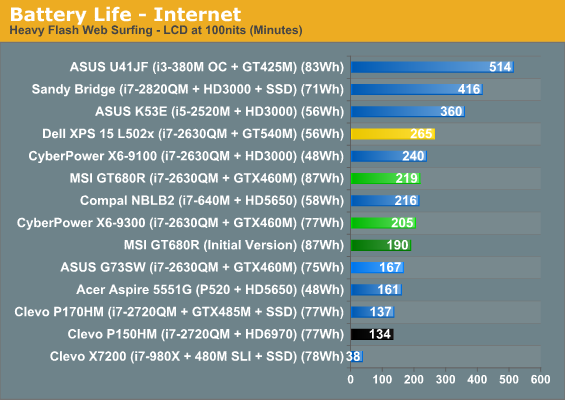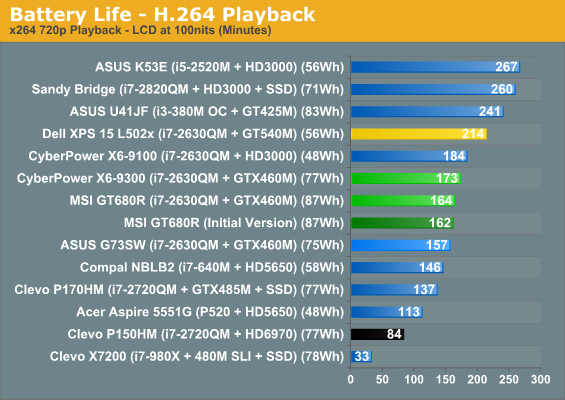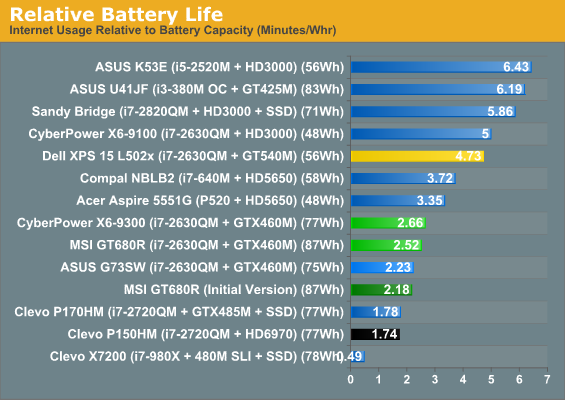CyberPower's X6-9300 and MSI's GT680R: Fighting for Your Mobile Gaming Dollar
by Jarred Walton on May 13, 2011 10:59 PM EST- Posted in
- Laptops
- Intel
- MSI
- Clevo
- Sandy Bridge
- CyberPowerPC
- NVIDIA
Battery Life and Power




The battery life results again fall right where expected. Without Optimus Technology, the GTX 460M puts a major dent on battery life, so even with 75Wh and larger capacities the best such notebooks can manage is just under four hours of mobility. In reasonable workloads like surfing the Internet, that drops down to about 3.5 hours (give or take), and H.264 decoding will last through most movies but not much more. MSI did make some changes to their power management, apparently, as our initial testing of the GT680R a few months back did worse than the P151HM and G73SW even though the battery capacity is 13% greater. The MSI also gets slightly less relative battery life, but that’s easily explained by the presence of a second hard drive.
We also ran some additional battery life tests, for those who want to do something like play a game while on battery power. The GT680R managed 100 to 125 minutes while looping 3DMark 03/06, and the P151HM lasted 130 to 140 minutes in similar testing. Recharging time on the MSI was 183 minutes (with the laptop powered on but sitting at the Windows desktop), and 143 minutes for the Clevo. Note that the Clevo battery consistently reported 0% wear while the MSI battery wear ranged from 6% to 9%, so that could also affect the battery life as well as charging time. Finally, idle battery life with the LCD at maximum brightness is 190 on the Clevo and 213 on the MSI. That represents an additional power draw of 3.2W for both the Clevo and MSI notebooks, but the interesting thing is that the P151HM manages nearly 330nits compared to just 230nits for the MSI at maximum brightness. We’ll get into the LCD differences in a moment, but it appears that the low contrast on the MSI is a result of the same backlight intensity letting though more light when it’s supposed to show black and less light when showing white—a double whammy with no benefit to the end user (other than cost).










44 Comments
View All Comments
hsew - Friday, May 13, 2011 - link
Wow, I must have been asleep longer than I thought! Does it support DirectX 47 and come with 24 EB of GDDR29 like they said it would? All while consuming 14nW at full load?JarredWalton - Friday, May 13, 2011 - link
I could tell you, but then the time travel police would be all over me. Sorry for the spoiler; please check back in 60 years for the full review!hsew - Friday, May 13, 2011 - link
I second the hopes that you get your hands on a G53SW. Specifically the XN1 model. I am curious as to whether or not it supports dual hard disks.z3r0slugfm - Saturday, May 14, 2011 - link
The G53SW does support dual hard drives and specifically the XN1 models come with the 2nd hdd caddy already installed.Iketh - Saturday, May 14, 2011 - link
I've been eyeballing the dell XPS 17" with a GT555M for a few weeks now... you can upgrade to the 2720qm and XFi sound as well as a few other upgrades and it comes out around $1550 (back-lit keyboard is stock)... please, please, PLEASE include results with a GT555M, I'm just not ready to pull the trigger yet (since I'd love to get this laptop with a 6970M instead). Screw optimus...Iketh - Saturday, May 14, 2011 - link
I'd like to add also that the G73 has superior cooling and may contribute to the higher scores from higher turbo clocks... it vents the entire chassis...JarredWalton - Saturday, May 14, 2011 - link
True, but in looking at the individual subtest scores, it's the storage benchmarks that are all about twice as fast on the ASUS G73SW and K53E. It makes me wonder if somehow the other laptops are only running the SATA drives in a reduced performance mode. Anyway, nothing I tried improved scores on any of the laptops, but ASUS consistently came out on top. I don't think the U41JF had the same performance benefit, though... I'd have to rerun the tests to verify.DanNeely - Saturday, May 14, 2011 - link
With the weaker clocks and lower core count the 555 is only going to have above 55-60% of the 560's performance in shader intensive games, and you take a similar sized hit from DDR3. Going the other direction its shading power is only about 20% higher than the 550. On paper it looks rather disappointing.JarredWalton - Saturday, May 14, 2011 - link
I think you got your numbers a bit mixed up, and you're probably talking about the GTX 460M and not a non-existent (an laptops) 560M. Anyway, the GTX 460M has 52.5% more *theoretical* shader performance than the GT 555M, and if you're looking at the GDDR5 model of the 555M, it has 20% more memory bandwidth. Or the reverse is that the 555M has 65% (worst case) of the 460's core performance. In actual games, you can see that the GT 540M (which is another 20% slower than the 555M) does reasonably well at moderate settings.DanNeely - Saturday, May 14, 2011 - link
I went off of the table in wikipedia, with a bit of extra googling the 560m appears to've paper launched last month with the first laptops using it expected at the end of this month. The main difference appears to be that the 560m will have shaders 100mhz faster.